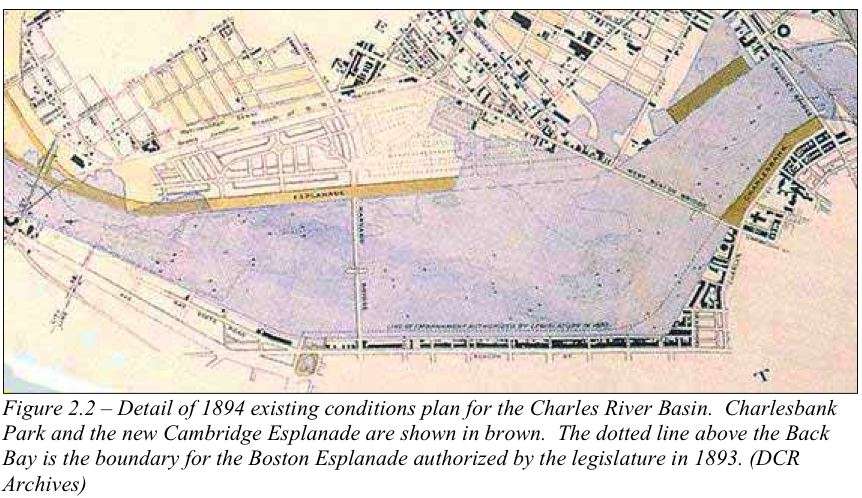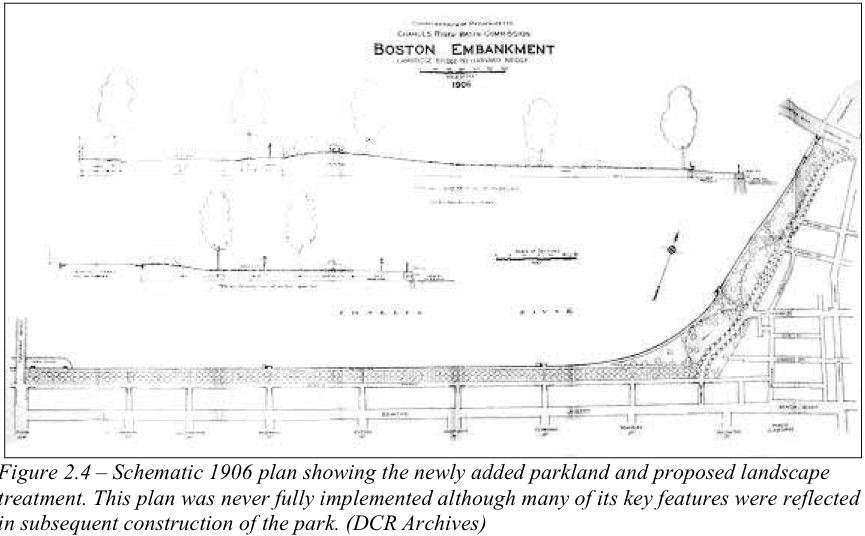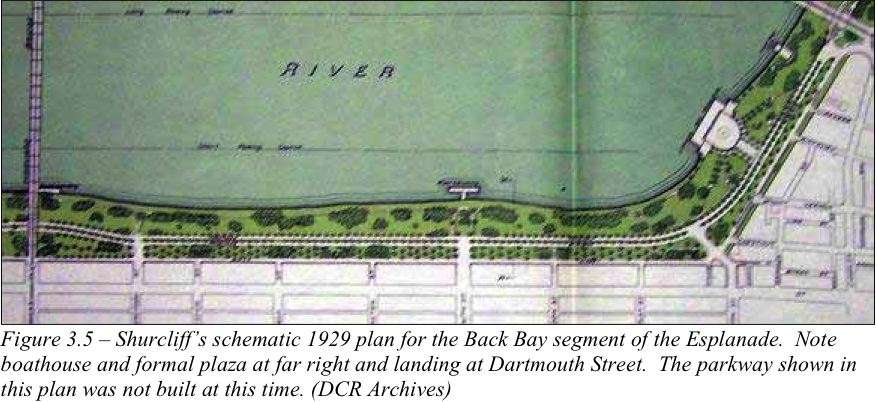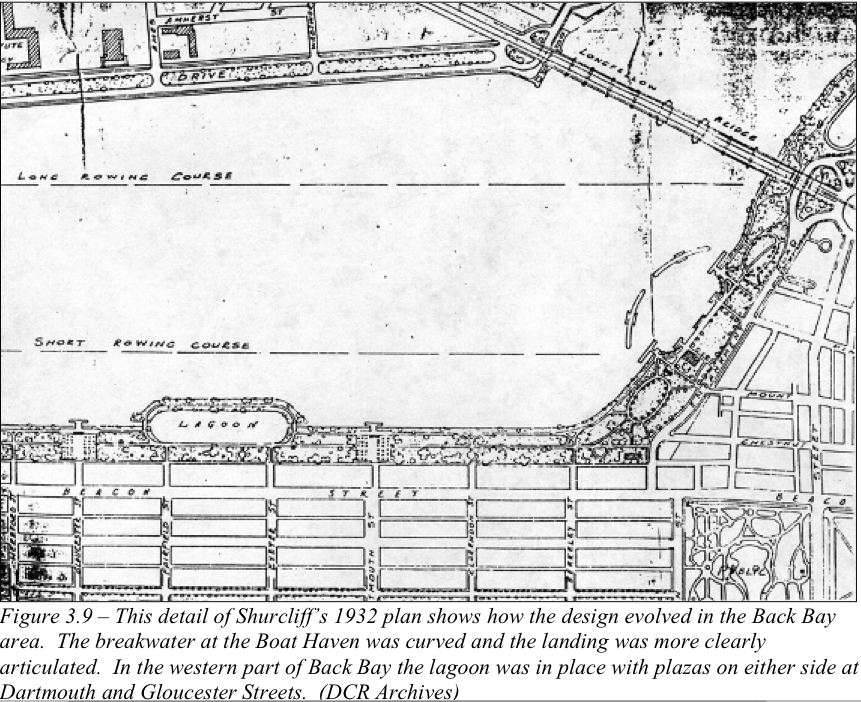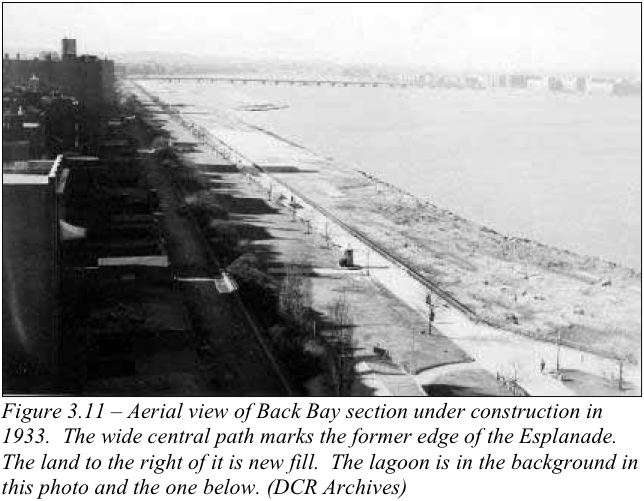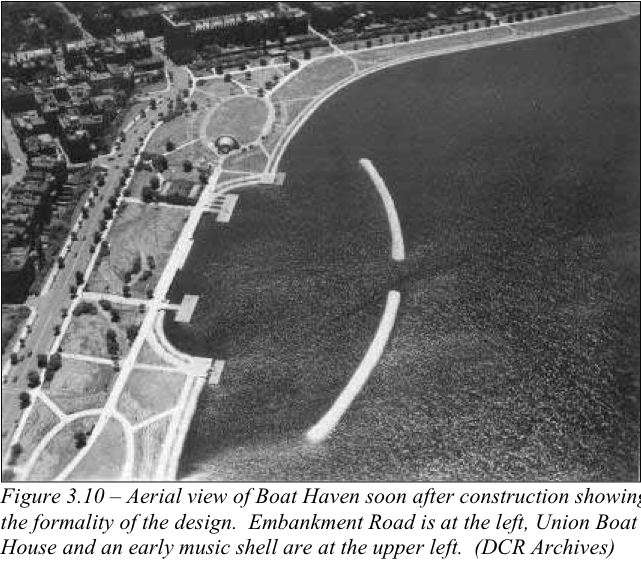You are using an out of date browser. It may not display this or other websites correctly.
You should upgrade or use an alternative browser.
You should upgrade or use an alternative browser.
Charles River Esplanade Given Landmark Status
- Thread starter briv
- Start date
Highway construction is a proven self-fulfilling prophecy. If you build it they will come, and if you expand it, more will come. I read about how in Vancouver they shut down two lane of a busy 4 lane bridge for bikes and pedestrians, and there were no major traffic problems. I think if you just cut out a lane on each side, most people would move grab the Pike in A-B. Eventually, you could just make the street just a residential road with two lanes, or one way, and have construction facing the esplanade. Plus, 100,000 more cars on the Pike helps the state budget (people would be pissed, but Big Brother would be happy)
OK, this is a little far fetched and would probably never happen but it came across my mind. You could also convert two lanes of traffic into light rail street cars (I am thinking like the D Line) that run from North Station, Charles/MGH, Beacon, Back Bay, Fenway, Harvard Ave, and Brighton Center, maybe continue into Newton or Watertown/Arlington or up to Harvard Square. But by just putting tracks on two lanes of former highway, you A) don't have to clear land and B) there wouldn't be any at grade crossing so the line would run fast like the D line.
As I write this I realize would be opening up the old A line
When I lived in Brighton, I would have loved this alternative to the B line to get downtown or to the esplanade.
OK, this is a little far fetched and would probably never happen but it came across my mind. You could also convert two lanes of traffic into light rail street cars (I am thinking like the D Line) that run from North Station, Charles/MGH, Beacon, Back Bay, Fenway, Harvard Ave, and Brighton Center, maybe continue into Newton or Watertown/Arlington or up to Harvard Square. But by just putting tracks on two lanes of former highway, you A) don't have to clear land and B) there wouldn't be any at grade crossing so the line would run fast like the D line.
As I write this I realize would be opening up the old A line
When I lived in Brighton, I would have loved this alternative to the B line to get downtown or to the esplanade.
Highway construction is a proven self-fulfilling prophecy. If you build it they will come, and if you expand it, more will come. I read about how in Vancouver they shut down two lane of a busy 4 lane bridge for bikes and pedestrians, and there were no major traffic problems. I think if you just cut out a lane on each side, most people would move grab the Pike in A-B. Eventually, you could just make the street just a residential road with two lanes, or one way, and have construction facing the esplanade. Plus, 100,000 more cars on the Pike helps the state budget (people would be pissed, but Big Brother would be happy)
I was going to suggest pretty much the same thing. Just phase it out in its current form. Lower the speed limit and reduce each direction by one lane. Let the traffic reconfigure. Give it some time. Reduce it again to one lane in each direction + one parking lane. Get rid of the medians, add crosswalks.
Shepard
Senior Member
- Joined
- Mar 20, 2009
- Messages
- 3,518
- Reaction score
- 68
Esplanade, pre-Storrow drive.
Last edited by a moderator:
Wow, not what I was expecting when I clicked that link. Thank you.
I've mentioned before on this forum that I think Storrow Drive is Boston's greatest fixable mistake. I really hope I see the cursed thing destroyed in my lifetime. So much hate for that road.
I've mentioned before on this forum that I think Storrow Drive is Boston's greatest fixable mistake. I really hope I see the cursed thing destroyed in my lifetime. So much hate for that road.
Any idea what street in the Back Bay this corresponds to? I was trying to match up birds-eye views on Live Maps but I couldn't find a set of buildings matching those in the photo.
After looking some more on Street View, I think this might be more or less the same view --
http://maps.google.com/maps?f=q&sou...=RBMOGgtVJbxmwhcDszIV1A&cbp=12,105.31,,0,0.92
A view from Back Street here --
http://maps.google.com/maps?f=q&sou...=BHpL5846AUlJbTBbpQNddA&cbp=12,94.82,,0,-2.17
The photo was shot from where is now the Harvard Bridge as it goes over the eastbound Storrow Drive lanes. Here is a photo taken today placed next to the 1916 shot, taken from about the same spot.
http://www.flickr.com/photos/87614014@N00/3773234405/sizes/l/in/photostream/
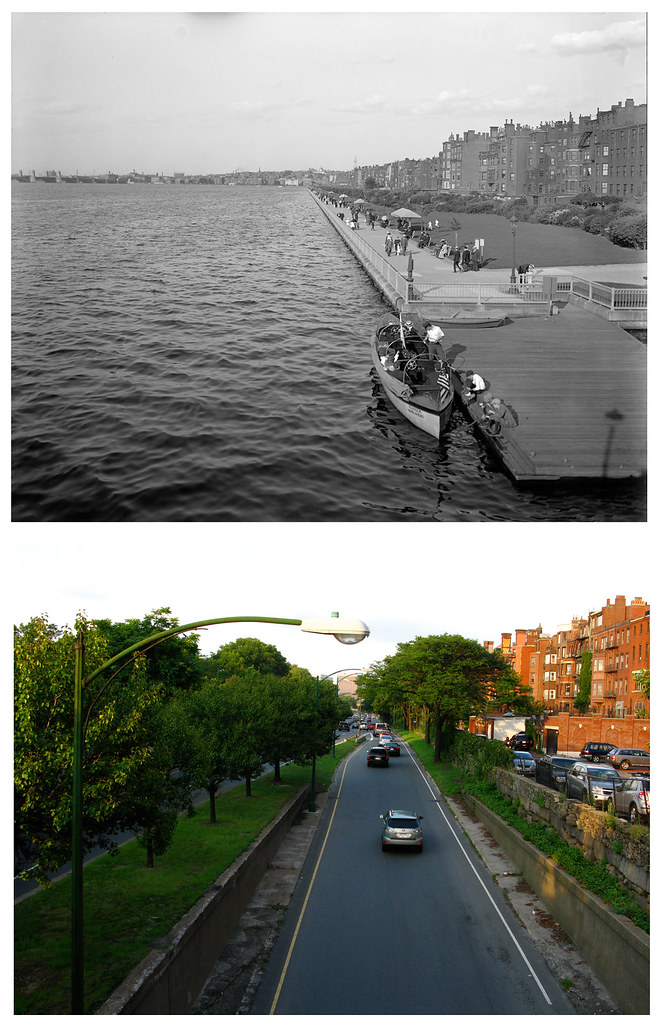
http://www.flickr.com/photos/87614014@N00/3773234405/sizes/l/in/photostream/

Shepard
Senior Member
- Joined
- Mar 20, 2009
- Messages
- 3,518
- Reaction score
- 68
Fantastic eye!
Even while I understand the notion that during the time when Storrow was built, automobiles were new, exciting, and the wave of the future, it's still hard to believe that enough people agreed that these strips of disjointed asphalt were better for the city than a riverside boardwalk...
Even while I understand the notion that during the time when Storrow was built, automobiles were new, exciting, and the wave of the future, it's still hard to believe that enough people agreed that these strips of disjointed asphalt were better for the city than a riverside boardwalk...
kz1000ps
Senior Member
- Joined
- May 28, 2006
- Messages
- 8,980
- Reaction score
- 11,798
- Joined
- May 25, 2006
- Messages
- 7,034
- Reaction score
- 1,875
Honestly the parkway in the 1929 plan is the best idea for dealing with Storrow Dr today. You can hate on the highway all you want but the fact is it is a vital transportation link and a beautiful drive. Slowing the traffic but not stopping it would make the park more humane while keeping the link alive.
Boston02124
Senior Member
- Joined
- Sep 6, 2007
- Messages
- 6,893
- Reaction score
- 6,639
reminds me of the Greenway ,nice old pix's/ maps KZ1000ps thanks!
kennedy
Senior Member
- Joined
- Feb 12, 2007
- Messages
- 2,820
- Reaction score
- 7
Didn't know where else to post this. Maybe it already has been.
from WBUR's website
BOSTON ? Like fly paper that comes with its own buzzing, Storrow Drive sticks to the Esplanade. The Esplanade came first. But like Canada geese that multiply and never go away, Storrow Drive crowds the Esplanade?s present, just as it limits its future.
And when the highway needs big repairs, the park it?s stuck to seems fated to surgery as well.
Now comes a big idea for something completely different: ?We should not entertain for a minute building a ?temporary? road through the Esplanade to rebuild this mistake,? says MIT professor and former Secretary of Transportation Fred Salvucci.
Taking Storrow Drive down ?certainly should be considered, in a very serious way,? Salvucci says.
Downsizing Storrow Drive would be just fine with Linda Cox, a resident of Beacon Hill and an ardent advocate for the Esplanade. ?First thing you need to know about James Storrow is, he had nothing to do with Storrow Drive,? she says. ?And he would have hated it.?
As workers take down light towers at the Hatch Shell, Cox launches us on an admiring tour of the three-mile long river park where a half million people had gathered a few days earlier.
?The fourth of July concert has been going on since 1929 when Arthur Fieldler founded the Esplanade Pops concerts,? Cox tells me. ?The Esplanade has been here for over a hundred years, but this spectacular really brought it to worldwide attention.?
When TV cameras joined the cannons, the fireworks and the Pops playing the 1812 overture in the 1970s, Boston and the Esplanade became synonymous with the Fourth of July.
The true grandeur of the park, built atop dredgings from the riverbottom, flowed from the landscaping genius of architect Arthur Shurcliffe, ?who is probably the most important landscape architect you never heard of,? in Cox?s esimation.
Shurcliffe loved Venice, boats and water. He wanted to make the park as much like Venice as possible. So after he was commissioned in the 1930s, he designed semi-circular islands, lagoons and three great granite neoclassical landings that stepped into the river.
Cox stops us on the western end of the Storrow Lagoon. ?As you look east, you can see the lovely symmetry of the lagoon,? she says. ?Imagine no cars. Just grass and trees.?
The view is stunning. It would resemble the reflecting pool in Washington, if the reflecting pool got sideswiped by a highway. ?It would have been even grander,? Cox says. ?You could walk over from the Back Bay.?
It was the most beautiful river park in the world, says Linda Cox, until in 1949, the State Legislature narrowly decided to build a high-speed highway through the Esplanade, to alleviate what supporters called ?disgraceful? traffic conditions.
Not a pretty story
Bitter defeat was compounded when the road was named after James Storrow, the Brahmin champion of the park, whose widow donated much of the money to build the Esplanade, with the stipulation there be no road. ?It?s not a pretty story,? Cox says.
The car was king, and former Secretary of Transportation Fred Salvucci says the power of road building corrupted the Metropolitan District Commission, MDC, a forerunner of the Department of Conservation and Recreation.
?There was a lot of power in becoming, effectively, the metropolitan road system,? Salvucci says. ?The MDC basically destroyed a good part of its own park system. Rather than being stewards of the park, they ended up being a road agency in all too many cases.?
Today, the ?parkway? known as Storrow Drive has a daily crowd of 131,000 cars. It?s almost 60 years old, and its tunnel badly needs replacement. Road managers have just completed the first phase of interim repairs and are about to begin a second phase to buy time while planning the major work ? and how they will handle traffic.
Commissioner of Conservation and Recreation Rick Sullivan had been on the job for only a few weeks in 2007 when he revived an unpopular plan from the Romney years to expedite reconstruction of the tunnel by building a temporary bypass road through part of the Esplanade.
Linda Cox was part of the outraged reaction. ?You know I threatened to chain myself to a tree,? she says.
Commissioner Sullivan says he has the scars to show what he?s learned from the public in 2007, and don?t count on him to be back with that idea. ?I?m not prepared to take anything absolutely off the table,? he says, ?but we heard everybody loud and clear the last time, so I think you?ll see a very different process, I think you?ll see a very different plan.?
Managing a parkway, that?s also a highway
In recent weeks, the mayor and the Boston City Council have approved landmark status for the Esplanade. It would give the park an added measure of protection from schemes like the bypass road.
But Commissioner Sullivan has opposed that designation. ?I don?t believe that there needed to be landmark status for the Esplanade,? he says. ?It?s already constitutionally protected.?
Herein lies the continuing contradiction of being commissioner of the Department of Conservation and Recreation: Rick Sullivan has one responsibility to protect the park, but another responsibility to manage a parkway that has become a highway for 131,000 cars a day.
Here?s Fred Salvucci?s solution: ?The way to solve the problem is to relieve him of the conflict of trying to be both the park commissioner and the transportation commissioner.?
Salvucci says so much has changed since the mistake of building Storrow Drive 60 years ago that it would be an even bigger mistake to mindlessly continue on that road now that there are so many other ways of getting into the city.
?You have the Turnpike; you have the Big Dig central artery, expanded capacity; you?ve got the Ted Williams Tunnel; you?ve got an MBTA that?s expanded considerably, with the Red Line and the Orange Line,? Salvucci lists off.
I put that question to Commissioner Rick Sullivan: Can he foresee a time when this road disappears?
?Standing here today, I guess I don?t see that it disappears,? he answers. ?I mean it really has become an important part of the transportation system in Boston and Cambridge. In fact, it?s even part of the evacuation route.?
But, Sullivan adds, ?who knows what the future holds.?
The Esplanade itself and the great granite landings have fallen into disrepair and need at least $10 million in work that isn?t being funded. The commissioner says he hopes the public process involving the future of Storrow Drive will begin within the year ? after his engineers turn from their focus on repairing bridges.
from WBUR's website
Pierce
Active Member
- Joined
- May 29, 2008
- Messages
- 461
- Reaction score
- 1
I'm shocked by those old photos... look at that park! No shade, and no people even on sunny warm afternoons. What a waste. Too bad the city didn't have the foresight at the time to build some skyscrapers along there, instead its just a green gash. Low density, so suburban. They would never do it like that in a real city like Hong Kong.

